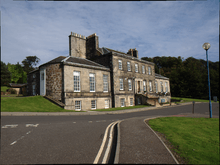David Dundas (politician)
Sir David Barnett Dundas, 2nd Baronet of Beechwood FRSE, QC (28 August 1803 – 30 March 1877) was a Scottish advocate, Liberal politician and agricultural improver.
Life

He was the son of Robert Dundas of Beechwood, 1st Baronet Dundas (1761–1835) and Matilda Cockburn (daughter of Archibald Cockburn. He was born at the family mansion of Beechwood House near Corstorphine in western Edinburgh on 28 August 1803.[1] In 1824 he acquired Henry Dundas's estate of Dunira in Perthshire. On his father's death in 1835 David became the 2nd Baronet.
Dundas was educated at Westminster School and at Christ Church, Oxford. He was called to the Bar at the Inner Temple in 1824, and appointed Queen's Counsel in February 1840.
He was elected to represent Sutherland in Parliament as a Liberal in March 1840. In July 1846 he was appointed Solicitor General for England and Wales. At the time, it was the normal practice that accepting ministerial office caused a by-election; he was re-elected on 28 July. In February 1846 he was knighted, a traditional perquisite of the office, but he resigned the position in March 1848 due to ill-health and returned to the backbenches. In May 1849 he was appointed Judge Advocate General, again re-elected in a by-election on 5 June, and made a member of the Privy Council on 29 June.
In 1851 he was elected a Fellow of the Royal Society of Edinburgh his proposer being John Cockburn, the wine merchant who founded Cockburns of Leith.[2]
In 1852 he commissioned the architect William Burn to completely remodel the mansion at Dunira.
He retired from politics in the 1852 general election, and was succeeded by the Marquess of Stafford, also a Liberal.
In retirement he lived and worked in his chambers at the Inner Temple; among other work, he served as a Trustee of the British Museum. His retirement from politics was not permanent; when Stafford was elevated to the House of Lords in March 1861 on becoming the third Duke of Sutherland, Dundas returned to Parliament. He stood down again in May 1867, being succeeded by Lord Ronald Sutherland-Leveson-Gower, the Duke's younger brother.
He died on 30 March 1877.
Family
He married twice: firstly in 1841 to Catherine Whyte Melville (d.1856); secondly in 1858 to Lady Lucy Anne Pelham (1815–1901), daughter of Thomas Pelham, 2nd Earl of Chichester. Lucy was a gifted amateur artist.
He had seven children by his first marriage: Georgina Catherine Dundas (1843–1859); Robert Dundas (1844–1865); David Pelham Dundas (1845–1856); Sir Sydenham James Dundas (1849–1904); Sir Charles Henry Dundas (1851–1908); Sir George Whyte Melville Dundas (1856–1934); Lady Jane Dundas (d.1929)
The second marriage produced a son. Sydenham Jaspar Dundas (1859–1909).[3]
Publications
- On the Potato Disease – Crop 1845 (1846)
References
- ↑ BIOGRAPHICAL INDEX OF FORMER FELLOWS OF THE ROYAL SOCIETY OF EDINBURGH 1783 – 2002 (PDF). The Royal Society of Edinburgh. July 2006. ISBN 0 902 198 84 X.
- ↑ BIOGRAPHICAL INDEX OF FORMER FELLOWS OF THE ROYAL SOCIETY OF EDINBURGH 1783 – 2002 (PDF). The Royal Society of Edinburgh. July 2006. ISBN 0 902 198 84 X.
- ↑ http://www.thepeerage.com/p9460.htm
- Oliver & Boyd's new Edinburgh almanac and national repository for the year 1850. Oliver & Boyd, Edinburgh, 1850
- Gordon Goodwin, "Dundas, Sir David (1799–1877)", rev. H. C. G. Matthew, Oxford Dictionary of National Biography, Oxford University Press, 2004 accessed 11 July 2006
- Leigh Rayment's Peerage Page
 "Dundas, David (1799-1877)". Dictionary of National Biography. London: Smith, Elder & Co. 1885–1900.
"Dundas, David (1799-1877)". Dictionary of National Biography. London: Smith, Elder & Co. 1885–1900.
External links
- Hansard 1803–2005: contributions in Parliament by David Dundas
| Parliament of the United Kingdom | ||
|---|---|---|
| Preceded by William Howard |
Member of Parliament for Sutherland 1840–1852 |
Succeeded by The Marquess of Stafford |
| Preceded by The Marquess of Stafford |
Member of Parliament for Sutherland 1861–1867 |
Succeeded by Lord Ronald Sutherland-Leveson-Gower |
| Political offices | ||
| Preceded by John Jervis |
Solicitor-General 1846–1848 |
Succeeded by Sir John Romilly |
| Preceded by William Goodenough Hayter |
Judge Advocate General 1849–1852 |
Succeeded by George Bankes |
| Baronetage of the United Kingdom | ||
| Preceded by Robert Dundas |
Baronet (of Beechwood) 1835–1877 |
Succeeded by Sydenham Dundas |